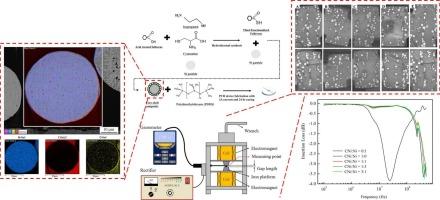High frequency signal performance of PDMS based pressure conductive rubber with core-shell onion-like carbon-Ni fillers
IF 5.1
3区 材料科学
Q2 MATERIALS SCIENCE, COATINGS & FILMS
引用次数: 0
Abstract
The development of pressure conductive rubber (PCR) with enhanced high-frequency performance is crucial for semiconductor testing interfaces. In this study, core shell onion-like carbon‑nickel (CNi) particles were synthesized via a hydrothermal process, systematically optimizing six key parameters to improve bonding interactions with metallic nickel. Functionalization of onion-like carbon (OLC) was confirmed by Fourier Transform Infrared (FTIR) analysis, demonstrating successful carboxyl (-COOH) surface modification, which facilitated thiol exchange reactions. Experimental results showed that insufficient acid treatment times led to incomplete core-shell structures, while excessive reaction temperatures induced sulfur crystallization, hindering coating uniformity. By refining synthesis conditions—including a 6-hour acid treatment, a reaction temperature of 130 °C, and a 72-hour reaction time—uniform CNi coatings with an average thickness of 450 nm were achieved, as validated by scanning electron microscopy (SEM) and energy dispersive X-ray spectroscopy (EDX) analyses. The influence of magnetic field strengths (0.7 T, 1.0 T, and 1.3 T) and magnetization durations (3 and 6 h) on particle alignment within a Polydimethylsiloxane (PDMS) matrix was investigated. The highest surface area packing factor (22.8 %) was observed under a 1.0 T field for 6 h, while saturation effects limited further improvement at 1.3 T. Insertion loss measurements revealed that the CNi:Ni ratio strongly influenced electromagnetic performance. The 1:1 ratio exhibited the widest bandwidth (−3 dB at 471.84 MHz) and the highest material density, suggesting an optimal balance between conductivity and dielectric properties. These findings demonstrate the potential of CNi-Ni composites for tunable microwave devices and high-speed semiconductor testing applications.

核壳型洋葱状碳-镍填料PDMS基高压导电橡胶的高频信号性能
开发具有增强高频性能的压力导电橡胶(PCR)对于半导体测试接口至关重要。本研究通过水热法合成了核壳状洋葱状碳镍(CNi)颗粒,系统优化了6个关键参数,以改善与金属镍的键合作用。傅里叶变换红外(FTIR)分析证实了洋葱样碳(OLC)的功能化,表明羧基(-COOH)表面修饰成功,促进了硫醇交换反应。实验结果表明,酸处理次数不足会导致核壳结构不完整,而反应温度过高会导致硫结晶,影响涂层的均匀性。通过优化合成条件,包括6小时的酸处理、130℃的反应温度和72小时的反应时间,获得了平均厚度为450 nm的均匀CNi涂层,并通过扫描电子显微镜(SEM)和能量色散x射线光谱(EDX)分析进行了验证。研究了磁场强度(0.7 T、1.0 T和1.3 T)和磁化时间(3和6 h)对聚二甲基硅氧烷(PDMS)基体中颗粒排列的影响。在1.0 T的电场作用6小时后,观察到最高的表面积填充系数(22.8%),而在1.3 T的电场作用下,饱和效应限制了进一步的提高。插入损耗测量表明,CNi:Ni比强烈影响电磁性能。1:1的比例显示出最宽的带宽(471.84 MHz时为- 3 dB)和最高的材料密度,表明电导率和介电性能之间达到了最佳平衡。这些发现证明了CNi-Ni复合材料在可调谐微波器件和高速半导体测试应用中的潜力。
本文章由计算机程序翻译,如有差异,请以英文原文为准。
求助全文
约1分钟内获得全文
求助全文
来源期刊

Diamond and Related Materials
工程技术-材料科学:综合
CiteScore
6.00
自引率
14.60%
发文量
702
审稿时长
2.1 months
期刊介绍:
DRM is a leading international journal that publishes new fundamental and applied research on all forms of diamond, the integration of diamond with other advanced materials and development of technologies exploiting diamond. The synthesis, characterization and processing of single crystal diamond, polycrystalline films, nanodiamond powders and heterostructures with other advanced materials are encouraged topics for technical and review articles. In addition to diamond, the journal publishes manuscripts on the synthesis, characterization and application of other related materials including diamond-like carbons, carbon nanotubes, graphene, and boron and carbon nitrides. Articles are sought on the chemical functionalization of diamond and related materials as well as their use in electrochemistry, energy storage and conversion, chemical and biological sensing, imaging, thermal management, photonic and quantum applications, electron emission and electronic devices.
The International Conference on Diamond and Carbon Materials has evolved into the largest and most well attended forum in the field of diamond, providing a forum to showcase the latest results in the science and technology of diamond and other carbon materials such as carbon nanotubes, graphene, and diamond-like carbon. Run annually in association with Diamond and Related Materials the conference provides junior and established researchers the opportunity to exchange the latest results ranging from fundamental physical and chemical concepts to applied research focusing on the next generation carbon-based devices.
 求助内容:
求助内容: 应助结果提醒方式:
应助结果提醒方式:


